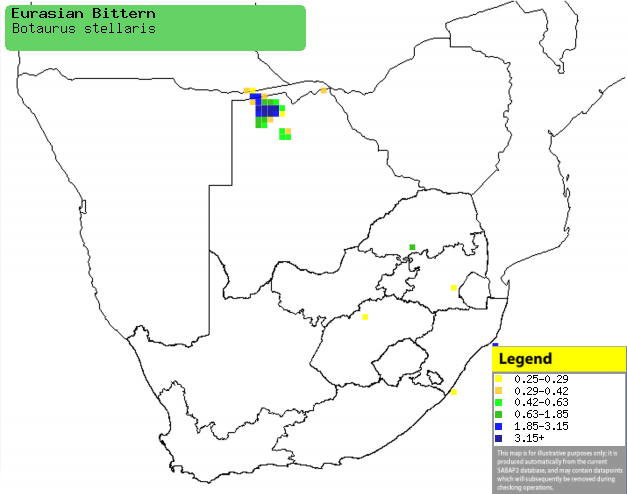|
Botaurus stellaris (Eurasian
bittern, Great bittern, Bittern)
Grootrietreier [Afrikaans]; Roerdomp [Afrikaans]; Umabu
[Zulu]; Shivo [Kwangali]; Khoiti-mohlaka [South Sotho]; Kgapu [Tswana];
Roerdomp [Dutch]; Butor étoilé [French]; Große rohrdommel [German];
Abetouro [Portuguese]
Life
> Eukaryotes >
Opisthokonta
> Metazoa (animals) >
Bilateria >
Deuterostomia > Chordata >
Craniata > Vertebrata (vertebrates) > Gnathostomata (jawed
vertebrates) > Teleostomi (teleost fish) > Osteichthyes (bony fish) > Class:
Sarcopterygii (lobe-finned
fish) > Stegocephalia (terrestrial
vertebrates) > Tetrapoda
(four-legged vertebrates) > Reptiliomorpha > Amniota >
Reptilia (reptiles) >
Romeriida > Diapsida > Archosauromorpha > Archosauria >
Dinosauria
(dinosaurs) > Saurischia > Theropoda (bipedal predatory dinosaurs) >
Coelurosauria > Maniraptora > Aves
(birds) > Order: Ciconiiformes
> Family: Ardeidae
Distribution and habitat
Occurs from the UK and southern Scandinavia to Siberia, Japan, Spain, Turkey and north-western and sub-Saharan Africa.
In southern Africa, it is rare in northern Botswana and the Caprivi Strip (Namibia), with a few
isolated populations in South Africa and eastern
Zimbabwe. It generally favours tall, dense emergent vegetation in large, seasonal
or permanent wetlands. It also occupies Papyrus (Cyperus
papyrus) swamps, flooded grassland and rice fields.
|
 |
|
Distribution of Eurasian bittern in southern Africa,
based on statistical smoothing of the records from first SA Bird Atlas
Project (©
Animal Demography unit, University of
Cape Town; smoothing by Birgit Erni and Francesca Little). Colours range
from dark blue (most common) through to yellow (least common).
See here for the latest distribution
from the SABAP2. |
Movements and migrations
Little known, although it is definitely not a
resident in any part of its distribution range, which suggests that
it might be locally migratory.
Food
It mainly eats fish, frogs and aquatic invertebrates, doing
most of its foraging by standing still or wading through shallow water, within
the effective cover of reeds and marsh plants.
Breeding
- Its breeding habits have barely been studied in southern Africa, so much of the following information
comes from other parts of the world.
- Monogamous or polygynous solitary nester, as one male may have up to
about five mates. It is highly territorial - males fight aerially in an attempt to stab
each other, sometimes resulting in death.
- The nest is a shallow, saucer-shaped platform of sedges, reed stems,
grass and rushes, typically placed in dense vegetation close to to the water
surface.
- Egg-laying season is from September-March.
- It lays 2-4 eggs, which are incubated solely by the female for about
25-28 days.
- The chicks are fed by the female with food provided by the male,
learning to fly at roughly 50-55 days old.
Threats
Critically endangered in South Africa, as it has an
extremely small population in the country, largely due to the draining of
wetlands, disruption of stream flow and other types of human disturbance. It was
previously common across much of southern Africa, excluding the most arid areas,
but it now has an estimated population of just 233-344 birds in the region.
References
-
Hockey PAR, Dean WRJ and Ryan PG 2005. Roberts
- Birds of southern Africa, VIIth ed. The Trustees of the John Voelcker
Bird Book Fund, Cape Town.
|
